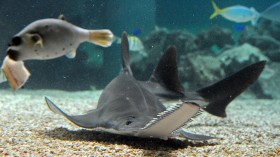NASA's Dawn spacecraft is closing in fast on the protoplanet Ceres - one of two asteroids in our solar system so large that they may even boast their own unique surfaces and thin atmospheres. Imagery taken tens-of-thousands of miles away has now revealed two intriguing bright spots on the asteroid's surface, and experts have absolutely no idea what they could be.
The brightest of the two spots was first identified when Dawn was more than 10 times its current distance from Ceres. You can notice the dot in an animated GIF, as compiled from images snapped back in January. Experts at the time had no idea what they were seeing, but admitted that with a resolution of 27 pixels, they were hard-pressed to make out anything at all - aside from the telltale shadows of craters.
Dawn is slowly closing in on the never-before-visited protoplanet with its unique ion propulsion system, and can now clearly make out those craters in stunning detail.
Unfortunately, "the brightest spot continues to be too small to resolve with our camera, but despite its size it is brighter than anything else on Ceres," Andreas Nathues, lead investigator for the framing camera team at the Max Planck Institute for Solar System Research, Gottingen, Germany, said in a statement. "This is truly unexpected and still a mystery to us." (Scroll to read on...)
A full rotation of the planet has also revealed another, fainter bright spot not too far away from the original. And while this may seem like it would just add to the mystery, Chris Russell, principal investigator for the Dawn mission, explained that this may be a valuable clue.
"Ceres' bright spot can now be seen to have a companion of lesser brightness, but apparently in the same basin. This may be pointing to a volcano-like origin of the spots, but we will have to wait for better resolution before we can make such geologic interpretations," he said.
So what's the point of taking all these photos if they really don't show much? Aside from it serving as an intriguing guessing game for the Dawn team, the images will also help NASA determine how and when to position the spacecraft - correcting trajectory or aiming for an important flyby.
It's all part of a decision-making process eight years in the making, since Dawn launched in 2007.
"Now, finally, we have a spacecraft on the verge of unveiling this mysterious, alien world," Marc Rayman, chief engineer and mission director of the Dawn mission, said in a statement. "Soon it will reveal myriad secrets Ceres has held since the dawn of the solar system."
For more great nature science stories and general news, please visit our sister site, Headlines and Global News (HNGN).
- follow Brian on Twitter @BS_ButNoBS.
© 2024 NatureWorldNews.com All rights reserved. Do not reproduce without permission.
![Severe Thunderstorm Alert: Tornadoes, Damaging Winds and Hail Possible from Upper Ohio Valley to Northeast US [NWS]](https://1471793142.rsc.cdn77.org/data/thumbs/full/70161/280/157/50/40/severe-thunderstorm-alert-tornadoes-damaging-winds-and-hail-possible-from-upper-ohio-valley-to-northeast-us-nws.jpg)



